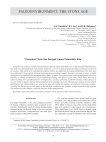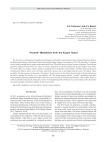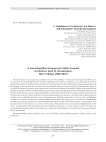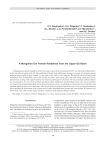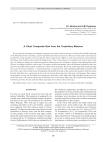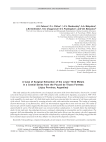Archaeology, Ethnology & Anthropology of Eurasia @journal-aeae-en
Статьи журнала - Archaeology, Ethnology & Anthropology of Eurasia
Все статьи: 524
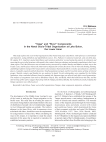
"Taiga" and "river" components in the Nanai socio-tribal organization at lake Bolon, the Lower Amur
Статья обзорная
Бесплатно
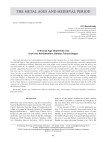
A Bronze Age shaft-hole axe from the northwestern Baraba forest-steppe
Статья научная
This study introduces a crested shaft-hole axe found on the southern shore of Lake Maidan, Vengerovsky District, Novosibirsk Region. Such random finds are regarded as markers of Bronze Age landscape zones and transportation routes in southwestern Siberia. Shaft-hole axes with slight crests occurred on this territory from the mid to late 2nd millennium BC. In addition to such axes, several casting molds made of clay, stone or metal have been found, possibly suggesting that axes were not only imported but also manufactured locally. These random finds of shaft hole axes can be considered markers of the complex, mirroring not only Middle and Late Bronze Age distribution areas, but also a considerable northward shift of landscape borders during an episode of climatic change, as well as indicating key routes for the migration of people associated with various traditions and objects. The mapping of various subtypes of shaft-hole axes from the Baraba forest-steppe revealed one such route, leading northward from southwestern Siberia to the Vasyugan Swamp. Apart from the series of axes from Baraba, certain cemeteries, such as Stary Tartas-4, yielded miniature replicas used as personal adornments. This feature links the north of the western part of the axes' distribution area (the forest-steppe zone of the Ob-Irtysh watershed) with its eastern part – the Minusinsk Basin.
Бесплатно
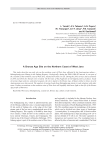
A Bronze Age site on the northern coast of West Java
Статья научная
This study describes an early site on the northern coast of West Java, affected by the Austronesian culture—Subanglarang near Binong in the Subang Regency. Geologically, during the 2000–1000 BP interval, it was part of the coastline of the northern coast of West Java, situated more than 5 m asl. During the 2013 surveys and excavations in 2016 and 2018, five burials were revealed. On the basis of the fragments of red-slipped pottery, pickaxes, beads of various shape and size, and metal weapons, the site is dated to the Bronze Age. Artifacts similar to those of early Austronesians were discovered. The analysis of various beads from Subanglarang attests to trade relations with other areas. Further excavations on the northern coast of West Java will hopefully shed more light on the life of the Bronze Age people of that area.
Бесплатно
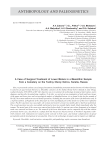
Статья научная
Here, we present the earliest case of surgical treatment of mandibular permanent molars known in Northern Eurasia. It concerns an aged woman buried at a Mesolithic cemetery on the Yuzhny Oleniy Ostrov (Island) in Lake Onega, southern Karelia, 8250–8050 cal BP. Our objective was to reconstruct the technology of surgical intervention, and to diagnose and describe the underlying condition. To do this, we carried out an examination of teeth and bone tissues of the upper and lower jaws and a traceological analysis of identified lesions. As we found, in the last few months of her life, the woman underwent several dental operations, including the extraction of the lower left third molar and, in a stepwise fashion, of fragments of the distal part of crown and lingual part of the distal root of the lower right first molar. The first operation was successful—the woman survived for at least two months after it had been performed. The second operation was also successfully performed at least two months before death, likely immediately after the trauma. The mesial part of the crown was removed just before death. No ancient cases where fragments of an injured tooth were removed are known to us. The removal of the lower third molar can be compared only with the earliest previously known case, described in a sample from the Pucará de Tilcara fortress in Northern Argentina (15th–16th centuries AD). Indications for surgery partly coincide in both cases, and include complications of apical periodontitis and the development of osteomyelitis. However, the technology of surgery and its logistics are different.
Бесплатно
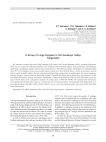
A Group of Large Kurgans in the Suusamyr Valley, Kyrgyzstan
Статья научная
We introduce recently discovered large kurgans of the Saka period in the Suusamyr valley, northern Kyrgyzstan. There are two cemeteries with large mounds, each of which is surrounded by ditches, stone enclosures, and ramparts. Apparently, each kurgan and the constructions around it form a whole burial complex. The kurgans are rounded in plan view, 30–73 m in diameter. Some were possibly square in plan view. West of them, there is a line of enclosures, most of which consist of eight boulders. In terms of nature and form of the constructions around kurgans, the burial complexes fall into six types, each of which is described in detail. Parallels are found among Early Iron Age cemeteries in the Tian Shan, Semirechye, central and eastern Kazakhstan. Common and distinctive features of the Suusamyr group are listed. On the basis of the comparative analysis, the group dates to 800/700–200 BC. We conclude that the kurgans were destined for the Saka elite, and were constructed over several generations. The materials of the study allow us to state that the alpine Suusamyr valley, which is hard to access, was a key political and/or cult center of the Tian Shan in the Saka period.
Бесплатно
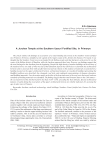
A Jurchen temple at the Southern Ussuri fortified site, in Primorye
Статья научная
The article outlines the fi ndings of excavations of a ritual building discovered at the Southern Ussuri fortifi ed site (Primorye Territory), identifi ed as the capital of the Xupin county of the Jurchen Jin Dynasty. Previously it was thought that the Southern Ussuri town was founded by the Balhae people and that during its early period it was the center of the Balhae district of Shuaibin, while the Jurchens appeared there later. However, our fi ndings suggest that the town belonged to the Jurchens from the beginning. Despite the high density of modern buildings on the territory of the medieval town, our study of what was left of the habitation deposits has allowed us to determine the architectural horizons and to associate them with specifi c historical periods. Based on the analysis of materials excavated from a building located on the upper architectural horizon, architectural features of a medieval building representing the Buddhist tradition were described: the colonnade, roof style, and sculptural representations of dragons, phoenixes, and Buddhist immortals. New decorative motifs on the tiles of the front and eaves of the roof were discovered, and new standards of building materials were identifi ed. The fi ndings suggest that the ritual structure dates to the 13th century— the second period of the Jurchen Eastern Xia State (1234–1276), preceding the Yuan Dynasty. Special architectural features revealed during the excavations of the upper architectural horizon are reliable indicators for assessing the age of other sites in Primorye.
Бесплатно
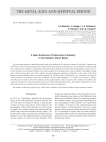
A New Andronovo (Fedorovka) Cemetery in the Eastern Irtysh Basin
Статья научная
We present the results of a multidisciplinary study of an Andronovo (Fedorovka) cemetery, Pogorelka-2, situated east of the Irtysh. Three burial mounds are described in detail, and elements of the funerary rite are outlined. All the mounds were constructed according to a single plan, characterized by a spatial separation of the burial platform, whereby one or several burials are surrounded by depressions in the ground. In two kurgans, these are four ditches with slightly sloping outer walls and steep inner ones. These ditches surround subsquare platforms with burials in the center. In the third kurgan, instead of ditches, there are small elongated pits. All the burials at Pogorelka-2 are cremations, as is typical of the Andronovo (Fedorovka) cemeteries in Baraba. On each burial platform, 1–3 burials were situated. Ceramics and other grave goods are described. Despite some specific features, they are typical of the Andronovo tradition. The cemetery belongs to the eastern part of the Andronovo (Fedorovka) distribution area. The analysis of funerary practices and goods reveals no contacts with the aboriginal Late Krotovo population.
Бесплатно

A Set of Clothing Items from the Iyus Hoard
Статья научная
This stud y focuses on details of clothing, belonging to the Iyus hoard, incidentally found in Khakassia in the 1970s. As in most other hoards from southwestern Siberia, this one includes elements of belt sets—buckles, plaques, pendants, and rings, paralleled by similar artifacts associated with the Tes culture of the 2nd century BC to 2nd century AD. The context of the ornaments is described, and the assembly and ritual use of belt sets are reconstructed. The composition of the Iyus hoard mirrors the process of a new Xiongnu clothing tradition being adopted by native south Siberians in their ritual and everyday practices. The “Scythian” component of the Iyus hoard is represented by rarities—ancient artifacts worn by natives in later times, and by replicas of ancient ornaments, whereas the “Xiongnu” component was more adaptive and includes items commonly used in everyday life. The co-occurrence of “Scythian” and “Xiongnu” artifacts within the same ritual assemblage testifies to the symbolic use of belt sets, evidenced by mid-1st millennium BC sites in southern Siberia.
Бесплатно
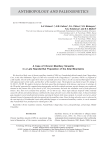
A case of chronic maxillary sinusitis in a late Neanderthal population of the Altai mountains
Статья научная
We describe a likely case of chronic maxillary sinusitis (CMS) in a Neanderthal skeletal sample from Chagyrskaya Cave, in the Altai Mountains. Signs of CMS were recorded in the Chagyrskaya 57 specimen, which is a fragment of a left maxilla. Alveoli of the upper fi rst molar are partially preserved, and so are the second and third upper molars, with adjacent parts of the walls, and the fl oor of the maxillary sinus. The fragment was found in layer 6b, dating to 53,100–51,100 BP. We analyze the factors that had caused the development of the disease, and assess its etiology. In the 3D-model, generated by computed microtomography, and in the original specimen, porotic changes were registered, situated at the fracture line of the alveoli of M1, lost post-mortem, and near the vestibular roots of both preserved molars. Also, there were isolated bone spicules, 1.0–2.6 mm in size. These signs indicate incipient CMS, evidently caused by chronic periodontal disease combined with a deep alveolar recess of the maxillary sinus. As the periodontal gap expanded, several small nutrient foramina, piercing the bottom of the sinus, merged. As a result, several oro-antral channels formed, whereupon the infection spread into the maxillary sinus. Since the deep alveolar recess is observed in the vast majority of Neanderthal crania with published images or reconstructed maxillary cavities, it can be assumed that Neanderthals were predisposed to odontogenic CMS.
Бесплатно


